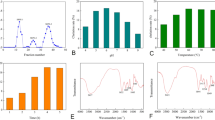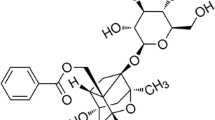Abstract
Purpose
Sulfated galactofucan (SWZ-4), which was extracted from Sargassum thunbergii, has recently been reported to show anti-inflammatory and anticancer properties. The present study aimed to evaluate whether SWZ-4 attenuates atherosclerosis in apolipoprotein E-knockout (ApoE-KO) mice by suppressing the inflammatory response through the TLR4/MyD88/NF-κB signaling pathway.
Methods
Male ApoE-KO mice were fed with a high-fat diet for 16 weeks and intraperitoneally injected with SWZ-4. RAW246.7 cells were treated with lipopolysaccharide (LPS) and SWZ-4. Atherosclerotic lesions were measured by Sudan IV and oil red O staining. Serum lipid profiles, inflammatory cytokines, and mRNA and protein expression levels were evaluated.
Results
SWZ-4 decreased serum TNF-α, IL-6 and IL-1 levels, but did not reduce blood lipid profiles. SWZ-4 downregulated the mRNA and protein expression of TLR4 and MyD88, reduced the phosphorylation of p65, and attenuated atherosclerosis in the ApoE-KO mice (p < 0.01). In LPS-stimulated RAW 264.7 cells, SWZ-4 inhibited proinflammatory cytokine production and the mRNA expression of TLR4, MyD88, and p65 and reduced the protein expression of TLR4 and MyD88 and the phosphorylation of p65 (p < 0.01).
Conclusion
These results suggest that SWZ-4 may exert an anti-inflammatory effect on ApoE-KO atherosclerotic mice by inhibiting the TLR4/MyD88/NF-κB signaling pathway in macrophages and therefore may be a treatment for atherosclerosis.








Similar content being viewed by others
Data Availability
All the data in this study are available upon reasonable request from the corresponding author.
References
Tsao CW, Aday AW, Almarzooq ZI, et al. Heart disease and stroke statistics-2022 update: a report from the American Heart Association. Circulation. 2022;145(8):e153–639.
Wu MY, Li CJ, Hou MF, et al. New insights into the role of inflammation in the pathogenesis of atherosclerosis. Int J Mol Sci. 2017;18(10):2034.
Hu ZP, Fang XL, Fang N, et al. Melatonin ameliorates vascular endothelial dysfunction, inflammation, and atherosclerosis by suppressing the TLR4/NF-kappaB system in high-fat-fed rabbits. J Pineal Res. 2013;55(4):388–98.
Michelsen KS, Wong MH, Shah PK, et al. Lack of Toll-like receptor 4 or myeloid differentiation factor 88 reduces atherosclerosis and alters plaque phenotype in mice deficient in apolipoprotein E. Proc Natl Acad Sci U S A. 2004;101(29):10679–84.
Yu XH, Zheng XL, Tang CK. Nuclear factor-kappaB activation as a pathological mechanism of lipid metabolism and atherosclerosis. Adv Clin Chem. 2015;70:1–30.
Cheng W, Cui C, Liu G, et al. NF-kappaB, a potential therapeutic target in cardiovascular diseases. Cardiovasc Drugs Ther. 2022.
Du FY, Li X, Li XM, et al. Indolediketopiperazine alkaloids from Eurotium cristatum EN-220, an endophytic fungus isolated from the marine alga Sargassum thunbergii. Mar Drugs. 2017;15(2):24.
Kang MC, Ding Y, Kim EA, et al. Indole derivatives isolated from brown alga Sargassum thunbergii inhibit adipogenesis through AMPK activation in 3T3-L1 preadipocytes. Mar Drugs. 2017;15(4):119.
Ou M, Sun X, Liang J, et al. A polysaccharide from Sargassum thunbergii inhibits angiogenesis via downregulating MMP-2 activity and VEGF/HIF-1alpha signaling. Int J Biol Macromol. 2017;94(Pt A):451–8.
Jin W, Liu B, Li S, et al. The structural features of the sulfated heteropolysaccharide (ST-1) from Sargassum thunbergii and its neuroprotective activities. Int J Biol Macromol. 2018;108:307–13.
Fu X, Cao C, Ren B, et al. Structural characterization and in vitro fermentation of a novel polysaccharide from Sargassum thunbergii and its impact on gut microbiota. Carbohydr Polym. 2018;183:230–9.
Bao Y, He X, Wu W, et al. Sulfated galactofucan from Sargassum thunbergii induces senescence in human lung cancer A549 cells. Food Funct. 2020;11(5):4785–92.
Anastyuk SD, Imbs TI, Shevchenko NM, et al. ESIMS analysis of fucoidan preparations from Costaria costata, extracted from alga at different life-stages. Carbohydr Polym. 2012;90(2):993–1002.
Li QM, Teng H, Zha XQ, et al. Sulfated Laminaria japonica polysaccharides inhibit macrophage foam cell formation. Int J Biol Macromol. 2018;111:857–61.
Zhang H, Wang ZY, Yang L, et al. In vitro antioxidant activities of sulfated derivatives of polysaccharides extracted from Auricularia auricular. Int J Mol Sci. 2011;12(5):3288–302.
Jin W, Zhang W, Wang J, et al. A study of neuroprotective and antioxidant activities of heteropolysaccharides from six Sargassum species. Int J Biol Macromol. 2014;67:336–42.
Jin W, Ren L, Liu B, et al. Structural features of sulfated glucuronomannan oligosaccharides and their antioxidant activity. Mar Drugs. 2018;16(9):291.
Zhuang C, Itoh H, Mizuno T, et al. Antitumor active fucoidan from the brown seaweed, umitoranoo (Sargassum thunbergii). Biosci Biotechnol Biochem. 1995;59(4):563–7.
Jin W, Liu G, Zhong W, et al. Polysaccharides from Sargassum thunbergii: monthly variations and anti-complement and anti-tumour activities. Int J Biol Macromol. 2017;105(Pt 2):1526–31.
Jin W, Zhang W, Liu G, et al. The structure-activity relationship between polysaccharides from Sargassum thunbergii and anti-tumor activity. Int J Biol Macromol. 2017;105(Pt 1):686–92.
Libby P. Inflammation and cardiovascular disease mechanisms. Am J Clin Nutr. 2006;83(2):456S–60S.
Hansson GK. Inflammation, atherosclerosis, and coronary artery disease. N Engl J Med. 2005;352(16):1685–95.
Zhou B, Pan Y, Hu Z, et al. All-trans-retinoic acid ameliorated high fat diet-induced atherosclerosis in rabbits by inhibiting platelet activation and inflammation. J Biomed Biotechnol. 2012;2012:259693.
Li SN, Wang X, Zeng QT, et al. Metformin inhibits nuclear factor kappaB activation and decreases serum high-sensitivity C-reactive protein level in experimental atherogenesis of rabbits. Heart Vessel. 2009;24(6):446–53.
Erickson B, Sperber K, Frishman WH. Toll-like receptors: new therapeutic targets for the treatment of atherosclerosis, acute coronary syndromes, and myocardial failure. Cardiol Rev. 2008;16(6):273–9.
Frantz S, Ertl G, Bauersachs J. Toll-like receptor signaling in the ischemic heart. Front Biosci. 2008;13:5772–9.
Feng X, Yuan Y, Wang C, et al. Autophagy involved in lipopolysaccharide-induced foam cell formation is mediated by adipose differentiation-related protein. Lipids Health Dis. 2014;13:10.
Xie C, Kang J, Ferguson ME, et al. Blueberries reduce pro-inflammatory cytokine TNF-alpha and IL-6 production in mouse macrophages by inhibiting NF-kappaB activation and the MAPK pathway. Mol Nutr Food Res. 2011;55(10):1587–91.
Lee S, Park Y, Dellsperger KC, et al. Exercise training improves endothelial function via adiponectin-dependent and independent pathways in type 2 diabetic mice. Am J Physiol Heart Circ Physiol. 2011;301(2):H306–14.
Li RY, Zhang WZ, Yan XT, et al. Arginyl-fructosyl-glucose, a major Maillard reaction product of red ginseng, attenuates cisplatin-induced acute kidney Injury by regulating nuclear factor kappaB and phosphatidylinositol 3-kinase/protein kinase B signaling pathways. J Agric Food Chem. 2019;67(20):5754–63.
Zhu T, Zhang W, Feng SJ, et al. Emodin suppresses LPS-induced inflammation in RAW264.7 cells through a PPARgamma-dependent pathway. Int Immunopharmacol. 2016;34:16–24.
Sun Z, Andersson R. NF-kappaB activation and inhibition: a review. Shock. 2002;18(2):99–106.
Zheng XN, Yang J, Xie T, et al. Effects of herbal-cake-separated moxibustion on blood lipid protein levels and expression of Toll-like receptor and nuclear factor genes in atherosclerotic plaques in hyperglycemia rabbits. Zhen Ci Yan Jiu. 2018;43(2):92–7.
Li Q, Zhao W, Zeng X, et al. Ursolic acid attenuates atherosclerosis in ApoE(-/-) mice: role of LOX-1 mediated by ROS/NF-kappaB pathway. Molecules. 2018;23(5):1101.
Funding
The study was supported by the Scientific and Technological Projects for Medicine and Health of Zhejiang Province (Grant No. 2021KY426).
Author information
Authors and Affiliations
Contributions
KF Zhu and XH Wang contributed equally to this article. All authors contributed to the design and interpretation of the study and to further drafts.
Corresponding author
Ethics declarations
Ethics Approval
The study was approved by the Institutional Animal Care and Use Committee (IACUC) at the Animal Lab Center of Zhejiang Academy of Medical Sciences.
Consent to Publish
All authors read and approved the final manuscript and agreed to submit it for consideration for publication.
Competing Interest
No benefits in any form have been received or will be received from a commercial party related directly or indirectly to the subject of this article.
Additional information
Publisher’s Note
Springer Nature remains neutral with regard to jurisdictional claims in published maps and institutional affiliations.
Rights and permissions
Springer Nature or its licensor holds exclusive rights to this article under a publishing agreement with the author(s) or other rightsholder(s); author self-archiving of the accepted manuscript version of this article is solely governed by the terms of such publishing agreement and applicable law.
About this article
Cite this article
Zhu, K., Wang, X., Weng, Y. et al. Sulfated Galactofucan from Sargassum Thunbergii Attenuates Atherosclerosis by Suppressing Inflammation Via the TLR4/MyD88/NF-κB Signaling Pathway. Cardiovasc Drugs Ther 38, 69–78 (2024). https://doi.org/10.1007/s10557-022-07383-3
Accepted:
Published:
Issue Date:
DOI: https://doi.org/10.1007/s10557-022-07383-3




